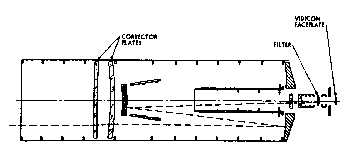tl;dr: At Voyager 1's distance of over 6 billion km, the Sun and the Earth were separated by only about 0.8 degrees. The streaks are scattered light inside the telescope (roughly speaking, "glare from the Sun"). At this distance, Earth's light is very weak, so even a small amount of scattered light will show up in the image.
The image is listed as PIA00452: "Solar System Portrait - Earth as 'Pale Blue Dot'". You can read further about it and photos of other planets that Voyager 1 took at about the same time in @Hobbes's helpful answer, and some more background about glare from the sun in Voyager 1's cameras in @called2voyage's helpful answer.
Original Caption Released with Image:
This narrow-angle color image of the Earth, dubbed 'Pale Blue Dot', is a part of the first ever 'portrait' of the solar system taken by Voyager 1. The spacecraft acquired a total of 60 frames for a mosaic of the solar system from a distance of more than 4 billion miles from Earth and about 32 degrees above the ecliptic. From Voyager's great distance Earth is a mere point of light, less than the size of a picture element even in the narrow-angle camera. Earth was a crescent only 0.12 pixel in size. Coincidentally, Earth lies right in the center of one of the scattered light rays resulting from taking the image so close to the sun. This blown-up image of the Earth was taken through three color filters -- violet, blue and green -- and recombined to produce the color image. The background features in the image are artifacts resulting from the magnification. (emphasis added)
Image Credit: NASA/JPL
Image Addition Date: 1996-09-12
According to Wikipedia:
Pale Blue Dot is a photograph of planet Earth taken on February 14, 1990, by the Voyager 1 space probe from a record distance of about 6 billion kilometers (3.7 billion miles, 40.5 AU), as part of the Family Portrait series of images of the Solar System. (emphasis added)
I looked up the position of Voyager 1, the Sun, and the Earth using the NASA JPL Horizons website, in J2000 Ecliptic coordinates. You can see that by this time Voyager 1 has "made it's move" and is already far out of the plane of the ecliptic (large negative Z value).
JD: 2447926.500000000, A.D. 1990-Feb-04 00:00:00.0000
Reference frame : ICRF/J2000.0
Coordinate systm: Ecliptic and Mean Equinox of Reference Epoch
Center body name: Solar System Barycenter (0) {source: DE431mx}
X (km) Y (km) Z (km)
Voy_1: -2.352905E+09, -4.483837E+09, 3.260641E+09
Sun: -7.232418E+04, 3.420464E+04, -4.602815E+03
Earth: -1.044322E+08, 1.042282E+08, -2.923541E+03
Using vectors pointing from Voyager 1 to the Sun and Earth, we can calculate the angular separation between the two as seen from the spacecraft.
$$\mathbf{r_E}=\mathbf{x_E}-\mathbf{x_{V1}} $$
$$\mathbf{r_S}=\mathbf{x_S}-\mathbf{x_{V1}} $$
$$cos(\theta) = (\mathbf{r_S} \cdot \mathbf{r_E}) \ / \ (r_Sr_E) $$
I get 0.821 degrees on February 14, 1990. So the streaks (scattered light artifacts) are the result of pointing at the Earth, which was separated by less than a degree from the sun. The active field of view (FOV) of the camera is 0.42 degrees square, but light at angles larger than that can still sometimes enter the telescope and reach the image sensor.
Even with various baffles in the optical system, a small amount of light was scattered. At over 6 billion kilometers (4 billion miles) from Earth, it is very faint compared to the sun, so even tiny amounts of scattered light inside the telescope will show up on an exposure long enough to make a bright dot when splitting Earth's light between four pixels.
The description of image PIA00450 includes more information about this image(PIA00452):
Although the planetary pictures were taken with the narrow-angle camera (1500 mm focal length) and were not pointed directly at the sun, they show the effects of the glare from the nearby sun, in the form of long linear streaks resulting from the scattering of sunlight off parts of the camera and its sun shade.

above: sketch of IRIS, Voyager's f=1500mm, f/8.5 camera, from here.

above: magnified and cropped part of the image, showing the bale blue light from our pale blue dot shared by four pixels, from Petapixel's The Pale Blue Dot: A Portrait of Earth Shot From More Than 4 Billion Miles Away.

above: Drawing of a Voyager spacecraft. The narrow angle camera is shown in the cluster of optical instruments at the top of the drawing. From here but a similar drawing is found on page 3 of Voyager Mission Status Bulletin, January 5, 1978. Found also here without credit, but with a caption.



